Related Research Articles

Quinine is a medication used to treat malaria and babesiosis. This includes the treatment of malaria due to Plasmodium falciparum that is resistant to chloroquine when artesunate is not available. While sometimes used for nocturnal leg cramps, quinine is not recommended for this purpose due to the risk of serious side effects. It can be taken by mouth or intravenously. Malaria resistance to quinine occurs in certain areas of the world. Quinine is also used as an ingredient in tonic water to impart a bitter taste.
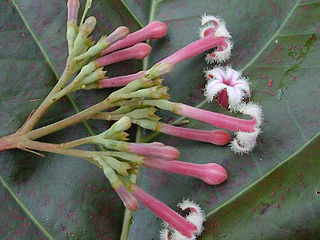
Cinchona is a genus of flowering plants in the family Rubiaceae containing at least 23 species of trees and shrubs. All are native to the tropical Andean forests of western South America. A few species are reportedly naturalized in Central America, Jamaica, French Polynesia, Sulawesi, Saint Helena in the South Atlantic, and São Tomé and Príncipe off the coast of tropical Africa, and others have been cultivated in India and Java, where they have formed hybrids.

Quinidine is a class IA antiarrhythmic agent used to treat heart rhythm disturbances. It is a diastereomer of antimalarial agent quinine, originally derived from the bark of the cinchona tree. The drug causes increased action potential duration, as well as a prolonged QT interval. As of 2019, its IV formulation is no longer being manufactured for use in the United States.

Jesuit's bark, also known as cinchona bark, Peruvian bark or China bark, is a former remedy for malaria, as the bark contains quinine used to treat the disease. The bark of several species of the genus Cinchona, family Rubiaceae indigenous to the western Andes of South America, was discovered as a folk medicine treatment for malaria by Jesuit missionaries in Peru during the 17th century.

Chloroquine is a medication primarily used to prevent and treat malaria in areas where malaria remains sensitive to its effects. Certain types of malaria, resistant strains, and complicated cases typically require different or additional medication. Chloroquine is also occasionally used for amebiasis that is occurring outside the intestines, rheumatoid arthritis, and lupus erythematosus. While it has not been formally studied in pregnancy, it appears safe. It was studied to treat COVID-19 early in the pandemic, but these studies were largely halted in the summer of 2020, and is not recommended for this purpose. It is taken by mouth.
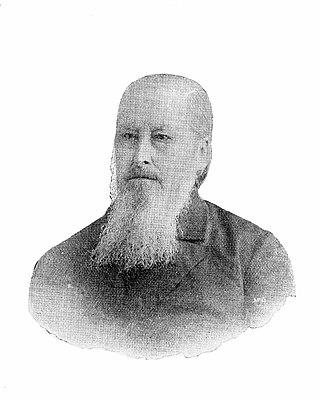
Charles Ledger was an alpaca farmer noted for his work in connection with quinine, a treatment for malaria.

Dubonnet is a sweet, aromatised wine-based quinquina, often enjoyed as an aperitif. It is a blend of fortified wine, herbs, and spices, with fermentation being stopped by the addition of alcohol. It is currently produced in France by Pernod Ricard, and in the United States by Heaven Hill Distilleries of Bardstown, Kentucky. The French made version is 14.8% alcohol by volume and the US version 19%. The beverage is famous in the UK for having been the favourite drink of Queen Elizabeth II and Queen Elizabeth The Queen Mother.
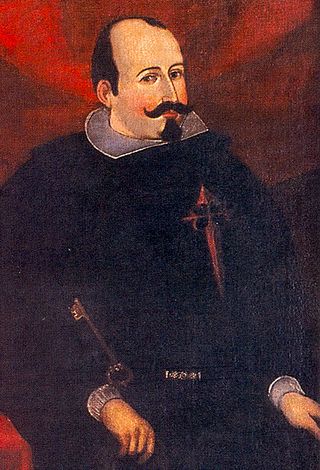
Luis Jerónimo Fernández de Cabrera Bobadilla Cerda y Mendoza, 4th Count of Chinchón, also known as Luis Xerónimo Fernandes de Cabrera Bobadilla y Mendoza, was a Spanish nobleman, Comendador of Criptana, Alcaide of the Alcázar de Segovia, Treasurer of Aragón, and captain general and Viceroy of Peru, from January 14, 1629, to December 18, 1639. His wife, Ana de Osorio (1599–1625), is credited as being one of the first Europeans to be treated with quinine, and as the person who introduced that medicine into Europe.

Cinchona officinalis is a South American tree in the family Rubiaceae. It is native to wet montane forests in Colombia, Ecuador, Peru and Bolivia, between 1600–2700 meters above sea level.
Malaria prophylaxis is the preventive treatment of malaria. Several malaria vaccines are under development.

Cinchona pubescens, also known as red cinchona and quina (Kina), is native to Central and South America. It is known as a medicinal plant for its bark's high quinine content- and has similar uses to C. officinalis in the production of quinine, most famously used for treatment of malaria.

Felice Bisleri was an Italian businessman, inventor and chemist.

The history of malaria extends from its prehistoric origin as a zoonotic disease in the primates of Africa through to the 21st century. A widespread and potentially lethal human infectious disease, at its peak malaria infested every continent except Antarctica. Its prevention and treatment have been targeted in science and medicine for hundreds of years. Since the discovery of the Plasmodium parasites which cause it, research attention has focused on their biology as well as that of the mosquitoes which transmit the parasites.
An aromatised wine is a fortified wine or mistelle that has been flavoured with herbs, spices, fruit or other natural flavourings.

John S. Sappington (1776-1856) was an American physician known for developing a quinine pill to treat malarial and other fever diseases in the Missouri and Mississippi valleys, where the disease was widespread. He later used the pill to prevent malaria. Because he both manufactured and sold "Dr. Sappington's Anti-Fever Pills", he became wealthy from his bestseller.
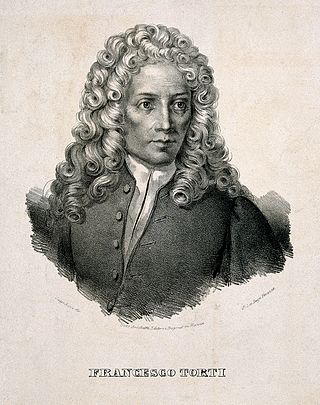
Francesco Torti was an Italian physician.
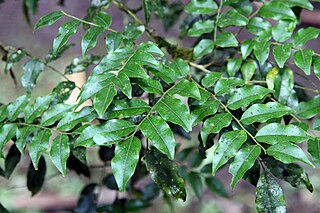
Myroxylon peruiferum, or quina, is a species of tree in the family Fabaceae. It is native to tropical forests of North and South America.
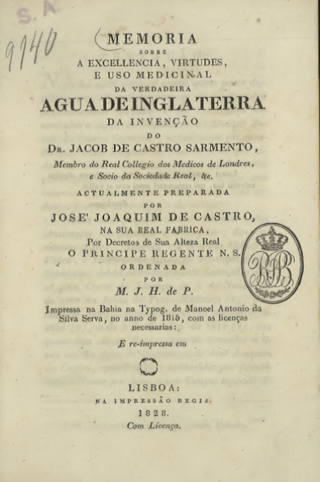
Água de Inglaterra was an example of the 'secret remedies' that were in vogue in Portugal during the 18th century. The name was used for various pharmaceutical preparations produced by several manufacturers from the end of the 17th century to the beginning of the 19th. In addition to the name, these preparations had in common the fact that the major therapeutic ingredient was the bark of the cinchona tree, from which quinine is obtained. Reference to the drug can be found in all Portuguese Pharmacopeias between 1681 and 1821.

Manuel Incra Mamani was a Bolivian cascarillero from Coroico. He may have been of either Quechua and/or Aymara descent. Mamani found a cinchona tree species that had a higher proportion of quinine than most others. This species went into Dutch commercial cultivation, providing most of the world's quinine well into the 20th century.
Sebastiano Bado, sometimes Latinized as Sebastianus Baldus, was a Genoese physician notable for his medicinal usage of cinchona bark in the 17th century.
References
- ↑ Holger Maehle, Andreas (1999). Drugs on Trial: Experimental Pharmacology and Therapeutic Innovation in the ... Rodopi. ISBN 9042007931 . Retrieved 30 November 2016.
- ↑ Lane Furdell, Elizabeth (2001). The Royal Doctors, 1485-1714: Medical Personnel at the Tudor and Stuart Courts. University Rochester Press. ISBN 9781580460514.
- 1 2 "Evaluation of Cinchona bark in the 17th and 18th centuries" . Retrieved 30 November 2016.
- ↑ "The Jesuit's Bark" . Retrieved 30 November 2016.